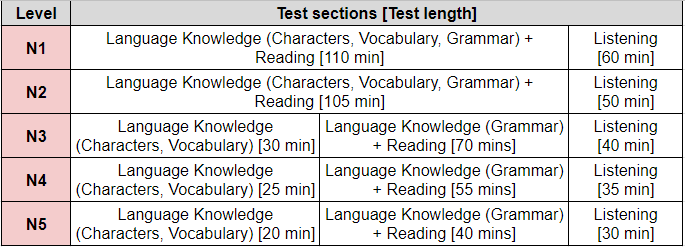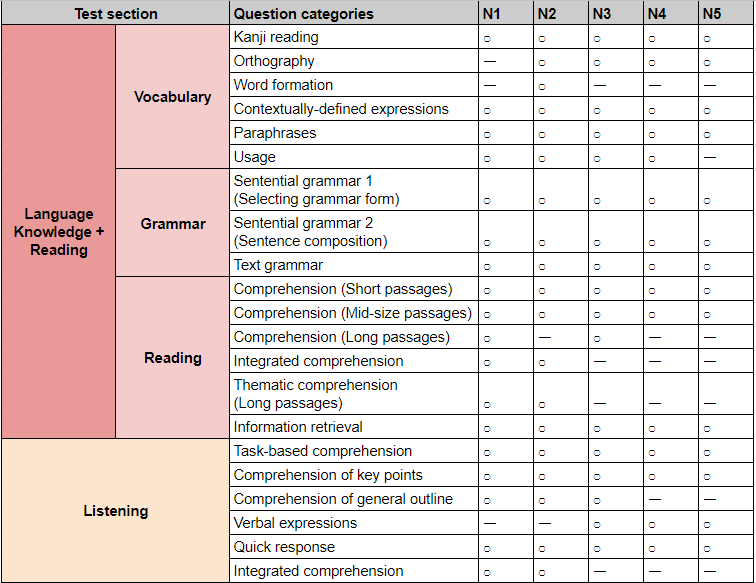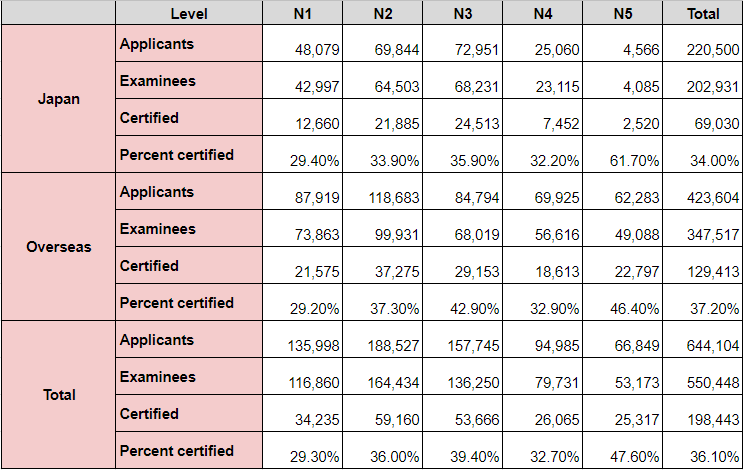When a foreigner in Japan takes a university entrance exam or goes for a job interview at a big company, they will often be asked for proof of their Japanese ability. The best way for them to formally demonstrate their Japanese proficiency is the Japanese Language Proficiency Test (JLPT). This article will go into detail on the test, including what level you should aim for in order to achieve your goals in an efficient way.
About the Japanese Language Proficiency Test (JLPT)

The Japanese Language Proficiency Test (JLPT) is an exam set to measure the Japanese language ability of non-native speakers. First held in 1984, it is the most widely taken Japanese exam in the world, with around 1 million candidates worldwide sitting the exam in 2018. Anyone who wants to study or work in Japan should consider taking the exam, as it is an achievement recognized and regarded by many establishments and has multiple uses, including gaining entrance into universities and vocational training schools, finding employment, or securing a pay raise or promotion.
○ Test Levels
The Japanese Language Proficiency Test is divided into 5 levels—N1, N2, N3, N4, and N5—with N1 being the most difficult and N5 being the easiest. Each level is split into a reading section and a listening section. The standards for each level are as follows.
<N1>
Your Japanese ability is at a very high level. You can understand Japanese used in a broad range of scenarios, from everyday conversation to business discussions and technical language. You can communicate fluently with Japanese native speakers.
[Reading] You can understand the contents of complex texts, and a high level of abstract language such as newspaper editorials and critiques. You can read texts that delve deeply into a range of topics, both following the narrative of the text and having a detailed understanding of the writer’s purpose/intention.
[Listening] You can listen to a broad range of scenarios, including conversations carried out at a natural speed, news bulletins, and lectures. You understand the narrative of the conversation, the information contained, the relationship between speakers, and the structure of the conversation in detail and will be able to grasp the main points of what is being said.
<N2>
In addition to understanding everyday scenarios in Japanese, you show some degree of understanding of Japanese in a wider range of contexts. You can communicate clearly on everyday topics and will be fairly proficient in business communication. You should also be able to carry out a discussion in Japanese at this level.
[Reading] You can read and understand the contents of texts with a clearly written argument, including newspaper and magazine articles and commentaries and simple critiques. You can read texts using everyday language, following the structure of the piece and understanding the main intentions of the writer.
[Listening] You understand exchanges at an almost natural speed, in a wider variety of scenarios than just everyday topics, by listening to conversations and news bulletins. You understand the flow of the conversation, detailed information, and the relationships between speakers, and grasp the main point of the conversation.
<N3>
You understand everyday Japanese to a degree. You can understand everyday conversation, but with business conversation, there may be cases where you do not understand information or where the speech is too fast for you to understand.
[Reading] You understand specific texts written using everyday language and can understand the main idea of short pieces of information by reading things such as newspaper headlines. You understand the main point of texts about everyday situations, if explanations are given for more difficult-to-understand expressions.
[Listening] You can listen to everyday conversations at close to native speed and can mostly understand specific elements of the conversation, along with the relationship of the speakers.
<N4>
You understand basic Japanese. You can understand the everyday conversation of Japanese natives to a degree, but at this level, you struggle to express your own ideas.
[Reading] You understand texts on familiar topics in everyday life, written using basic vocabulary and kanji.
[Listening] You can mostly understand conversations about everyday situations, when spoken at a slower than normal speed.
<N5>
You understand basic Japanese to a degree. At this level, you can carry out greetings and self-introductions.
[Reading] You understand words, phrases, and texts written in hiragana, katakana, and basic kanji used in everyday life.
[Listening] You can pick out the main points of short conversations about situations often encountered in everyday life or a classroom setting, when spoken slowly.
○ Test Sections
The exam is split into two sections: the first is language knowledge (grammar, vocabulary, and characters) and reading, and the second is listening. As the contents and difficulty of each test changes depending on the level, the lengths differ as follows.

○ Types of Test Questions
Each section of the exam contains multiple types of questions, each designed to measure a different skill. The aims of the question categories differ with each level. That said, there is no speaking or writing in the exam; it is a multiple-choice test where answers are recorded on an answer sheet. There is generally a choice of four answers, although in some listening sections, there are three. Below are the question categories for each level.
▼The Aims for Each Type of Question by Level
N1: https://www.jlpt.jp/guideline/pdf/n1.pdf
N2: https://www.jlpt.jp/guideline/pdf/n2.pdf
N3: https://www.jlpt.jp/guideline/pdf/n3.pdf
N4: https://www.jlpt.jp/guideline/pdf/n4.pdf
N5: https://www.jlpt.jp/guideline/pdf/n5.pdf

○ Test Dates and Sites
The Japanese Language Proficiency Test (JLPT) is held twice a year in July and December. In 2019, the test was held in all 47 prefectures in Japan. You can also take the test in many places overseas. In the same year, it was held in 46 and 75 countries/areas (in July and December, respectively).
*The July 2020 exam was canceled because of the coronavirus (COVID-19) outbreak. Please be aware that the December 2020 exam and subsequent tests may also need to be canceled.
○ Test Taker Data
The number of people taking the JLPT has risen from an initial 7,000 people back in 1984 to over 1 million in 2018. To compare this to the increase in students studying Japanese, according to the Survey on Japanese-Language Education Abroad carried out by the Japan Foundation, there were 580,000 overseas students of Japanese in 1984. By 2018, this number had risen to around 3.65 million.
There are no restrictions on who can take the exam, such as age limits or required academic qualifications, and it attracts a wide range of candidates from elementary school age onward. If you look at information on the background of applicants for the second exam held in 2018, at 42.2%, the highest number of candidates were in higher education (college, university, and graduate students). At 27.6%, the next highest category was those in employment (including company workers, government workers, teaching staff, and the self-employed). Altogether, these two categories accounted for around 70% of the candidates.
○ Pass Rates
While pass rates vary from test to test, the average pass rate for levels N1-N4 is at around 30%, and the pass rate for N5 stands around 50%, so it is not considered an easy test. In addition to basic language study, it is important to thoroughly revise past questions. Below is the data from the July 2019 exam.

The Advantages of Taking the JLPT
As the best-known Japanese language test around the world, with over 1 million candidates sitting the test, there are many advantages to taking the Japanese Language Proficiency Test. It can be accepted as extra school credit. It is looked on favorably within companies and highly regarded in society. Depending on the level you achieve, it also has the advantage of being accepted as proof of your Japanese level when you are taking a university entrance exam or applying for jobs, so taking it can prove a shrewd choice! Below is an outline of some more specific advantages.
(1) People who have achieved N1 or N2 will receive points towards Japan’s points-based preferential immigration program for highly-skilled foreign professionals.
(2) It is one of the conditions for taking national examinations in Japan: National exams that require candidates to have achieved JLPT N1 include those for doctors, dentists, registered nurses, dental hygienists, physiotherapists, emergency paramedics, and veterinarians.
(3) It is a prerequisite for sitting the Assistant Nursing Examination: People who have trained and qualified as a nurse in a foreign country need to have achieved JLPT N1 in order to sit the Assistant Nursing Examination in Japan.
(4) It can be used as a substitute for part of the Junior High School Equivalency Exam: Foreigners who have achieved N1 or N2 of the JLPT will be exempt from taking the Japanese-language portion of the Junior High School Equivalency Exam in Japan.
(5) It is a prerequisite for applicants to be nurses and certified caregivers under the Economic Partnership Agreement (EPA): Applicants from Indonesia, the Philippines, and Vietnam who wish to work in Japan as nurses or certified caregivers must have achieved JLPT N5 (Indonesia, Philippines) or at least N3 (Vietnam).
Test Registration Process
Procedures differ depending on whether you are registering to take the test in Japan or overseas. Below is an outline of the process for both options.
○ If You Are Taking the Test in Japan
1. Check the test dates on the Japanese Educational Exchange and Services (JEES) website (https://info.jees-jlpt.jp/) and register for your MyJLPT account. (You can register at any time.)
2. Apply via the JEES website and pay the test fee. (You can register from around 3 months before the date of the test.)
3. JEES will send your test voucher about 1 month before the date of the exam.
4. Take the test.
5. Around 2 months after sitting the test, JEES will send a notification of your results. (You can also check your results by logging into your MyJLPT account.) If you have passed, you will also receive your Certificate of Japanese-Language Proficiency.
○ If You Are Taking the Test Overseas
1. Use the official website to search for your nearest city with a hosting institution in your country/area (https://www.jlpt.jp/e/application/overseas_list.html).
2. Find out how to apply to your chosen institution, and obtain an application form and guidance pack.
3. Thoroughly read the guidance pack, fill out the application form following the rules of your host institution, and pay the application fee. (You can apply from around 3–4 months before the date of the exam.) *As the application period may vary from place to place, be sure to check the registration period with your host institution.
4. You will receive your test voucher from the host institution.
5. Take the test.
6. Around 2 months after sitting the test, you will receive your JLPT Certificate of Result and Scores from your host institution. If you have passed, you will also receive your Certificate of Japanese-Language Proficiency.
*This is the general procedure for overseas applications. The procedure may vary depending on the country/area, so please check with your host institution for specific instructions. Also, some cities will only host the test in July while others only host in December.
Receiving a Certificate as Proof of Passing the JLPT
If you need a certificate to apply for a job or further course of study, you can request a copy of your JLPT Certificate of Result and Scores. This certificate includes your test result and an itemized breakdown of your score for each section, and it is an official document that you can present to your school or company. Where to apply for your certificate will vary depending on where you took the test.
The application procedure for those who took the test in Japan is as follows:
○ Request Via MyJLPT
Login to MyJLPT, click on the “Test Result and Certificate Issuance” button, and fill out the required information. If your test was applied for by a group representative under the block registration system, only the group representative can apply for a certificate to be issued.
○ Request by Mail
Only those who sat their test in Japan can send a request by mail. Send the following three items to the Application Center:
(1) A copy of either your Test Result or Certificate of Japanese-Language Proficiency for the test you require a certificate for. If you do not have these, send a copy of your passport with your name and date of birth, along with the year you took the test.
(2) An application form for issuance of the JLPT Certificate of Result and Scores (for residents of Japan) or a note including your forwarding address, telephone number, and number of copies required.
(3) Pay the issuance fee (bank money orders or checks are not accepted)
① Residents of Japan: 1,000 yen per copy by postal money order
*An additional postal money order of 500 yen is required for deliveries by express mail (with record of receipt).
② Overseas Residents: 1,000 yen per copy by international postal money order
*An additional 1,000 yen per copy is required for EMS (Express Mail Service) by international postal money order.
*Please fill in the international postal money order as follows:
・Recipient Name (Pay to): Japan Educational Exchange and Services
・Recipient Address (Address): 4-5-29, Komaba, Meguro-ku, Tokyo 153-8503
▼Mail Address
JLPT Application Center (日本語能力試験 受付センター)
6F, Palaceside Building, 1-1-1, Hitotsubashi, Chiyoda-ku, Tokyo, 100-0003 (〒100-0003 東京都千代田区一ツ橋1-1-1 パレスサイドビル6階東コア)
TEL: 03-6686-2974 FAX: 03-6845-2544
The processing time is around 1-2 weeks for those living in Japan and more than 2 weeks for those living overseas. Also, there are often times where it could take longer than stated—when dealing with a high volume of applications, for instance—so try to send your application as early as possible.
Furthermore, while the test itself has no expiration date, please check with individual companies and institutions to see if they have a set time limit on how long ago you must have passed the test.
▼For more information about certificate issuance, follow the link below:
https://www.jlpt.jp/e/certificate/index.html
Test Levels Required for Specific Occupations

If you are planning to work in Japan, the JLPT level required varies by profession. Your job will grant you many opportunities to use and improve your Japanese ability, so once you know your level, you can step up to the challenge of using your Japanese in a native setting.
▼ Job options for people with various levels of the JLPT
N1: Most jobs are a viable option. E.g., office work, work dealing with contracts written in Japanese, hotel receptionist, floor staff in a fine-dining restaurant, etc.
N2: Jobs that may, at times, require supervision or support from a Japanese manager. E.g., convenience store clerk, restaurant floor staff, customer service roles that involve simple interaction with Japanese customers, etc.
N3: Floor staff in a buffet restaurant (all-you-can-eat service), staff at leisure facilities such as ski resorts, general non-customer facing roles (hotel room attendant, dishwasher, food preparation assistant), etc.
N4: General non-customer facing roles (hotel room attendant, dishwasher, food preparation assistant), production line jobs where a foreign language manual is available, etc.
N5: Non-customer facing services (hotel room attendant, dishwasher), simple jobs that offer support in a foreign language, etc.
Test Level Needed to Gain Residency in Japan
If you want to live in Japan, how does the JLPT factor into the necessary qualifications? The “Specified Skilled Worker (i)” visa status established in April 2019 and the “Designated Activities No. 46” status established in May 2019 both clearly outline the required levels of Japanese needed to gain these specific visas.
For the Specified Skilled Worker (i) visa, where work is limited to jobs in specific industries, workers must have achieved at least N4 of the JLPT or the Japan Foundation Test for Basic Japanese (JFT-Basic). (Foreigners who have successfully completed Technical Intern Training (ii) are exempt from these tests.) The Designated Activities No. 46 visa means candidates can work in field operations in areas including catering, hospitality, and nursing, that incorporate the technical background of an “Engineer/Specialist in Humanities/International Services” visa. To qualify for this, candidates must have obtained JLPT N1 or a score of 480 or more on the Business Japanese Proficiency Test (BJT).
There is no need to prove your Japanese ability for statuses of residence other than the two mentioned above. However, the reason for obtaining a Japanese visa is to perform certain activities in Japan, and in cases where it would be impossible to do this without speaking Japanese, you would naturally need appropriate language ability. For example, to obtain the Engineer/Specialist in Humanities/International Services visa, you must meet specific academic or work experience criteria, but there are no clear requirements for your Japanese ability. However, in most cases, to obtain a visa you need to be employed by a Japanese company, and most of the larger companies who can make it easy for you to obtain a visa would expect you to prove you had passed N1 or N2 at the interview stage. To get your working life in Japan off to a smooth start, it is preferable to at least have achieved JLPT N2. Having already obtained this when you begin job hunting can be a major asset in securing a position.
How to Pass the JLPT

You need to develop a strategy in order to pass the test. In the book “The Art of War,” author Sun Tzu said, “If you know your enemy and know yourself, in a hundred battles you will never be defeated.” Bearing in mind these words, let’s look at how to study for the JLPT!
○ Know Yourself
Finding out your current level is the first step to passing the JLPT. To know what you should aim for, first try out the free sample exam questions on the JLPT official homepage to find your current level (https://www.jlpt.jp/e/samples/forlearners.html). At this stage, there is no need to worry about your score, but it is important to be aware of your strengths and weaknesses.
Taking the test also gives you a good opportunity to reflect on how well you are doing. It is not just a case of whether you have passed or failed, but a chance to look at which areas you were able to do and which need work. Use the “Understanding score reports” section (https://www.jlpt.jp/e/guideline/results.html?pScanchor5) as a reference to make a plan of things you need to work on for the next time you take the test.
○ Know Your Enemy
The important things you need to know about the JLPT is how the sections of the test are scored and how a pass or fail mark is determined. To pass, your total score needs to be the same as or higher than the overall passing mark, and the number of points scored in each section need to be the same as or higher than the passing mark for that section (sectional passing mark). The key to passing is knowing how many points are needed to pass each section and understanding how the final score is decided.
Working on actual exam questions is an effective way to improve your Japanese ability and get used to the style of the test. We recommend the Official Practice Workbook, which is made up of questions featured in past exams, giving you a great opportunity to have a go at questions set out just like the real test.
▼Reference Books:
https://www.jlpt.jp/e/reference/books.html
Otherwise, there is plenty that you can do to prepare for the test in a relaxed fashion. When studying at home, set yourself a time limit to try and solve one set of questions at a time, and make sure you have researched the test venue and worked out how you will get there on the day of. Try out a range of study options and find out what works best for you.

Recently, more companies in Japan have started to hire globally for candidates with English as their main language, but traditionally, the level you have achieved on the JLPT has had a significant effect on whether you gain employment. Because of this, it is beneficial to try and complete one of the higher levels of the test before starting to look for work. For people planning to come and study in Japan who are thinking of working here in the future, it is a good idea to start working towards the test as soon as possible. You can take the JLPT as many times as you like. Use the main points of this article to find the most effective way for you to study for the test, and keep working until you get the results you are looking for from the JLPT.
If you want to give feedback on any of our articles, you have an idea that you’d really like to see come to life, or you just have a question on Japan, hit us up on our Facebook!
The information in this article is accurate at the time of publication.

